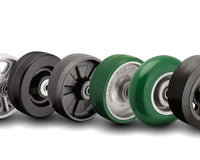Casters come in sizes big and small, with wheels hard or soft, rigs rigid or swivel, some with stems and others with plates. Some casters are made for furniture, others for industrial equipment, some for medical applications, and still others for foodservice and janitorial equipment.
Equipment with the right casters rolls smoothly and easily in its environment; equipment with the wrong casters is difficult to move and a struggle to push. Picking the right caster for an application can be a challenge. Understanding more about the differences between casters can help make choosing the right caster a lot easier.
Casters are a way of putting wheels on equipment and there are many different types of caster wheels. So, we should probably start with the wheels.
Caster Wheel Sizes
Wheels give us leverage, in fact, you can think of a wheel as a lever spun about a point – the axle is the fulcrum. Smaller wheels are well suited for light loads and large wheels for heavier loads. Caster wheel sizes are as small as 40mm (~1-5/8”) and as large as 18”, with many choices between.
The tread is the part of the wheel that comes in contact with the ground; it’s where the rubber meets the road, literally. Treads can be very soft, like a neoprene or thermoplastic rubber, or they can be hard, like phenolic, cast iron, or forged steel. Soft treads tend to be quieter and can roll over debris but can be harder to start and carry less load than hard treads. Caster wheel treads come in different shapes, generally crowned or flat. Crowned treads are easier to turn and flat treads can handle heavier loads. With all this in mind, there is no one perfect wheel for all applications but there are better choices for every application.
Bearings
Wheels spin about a point, the axle. Most wheels have a bearing between the wheel core and the axle. In fact, all wheels have a bearing, sometimes it’s just the same material as the wheel core. We call that a plain bore bearing.
Plain bore bearings are inexpensive and work well for lighter loads; furniture and general duty casters have plain bore bearings. Most industrial caster wheels, like those you’ll commonly see in factories, warehouses, and distribution centers, have either a roller bearing or ball bearing. Roller bearings are relatively inexpensive, durable, and make rolling the wheel a bit easier.
Ball bearings are a bit more expensive and make the wheel very easy to roll. Ball bearings are quiet, so they are also common in institutional casters like medical, food service, and office cart casters. Caster wheel design dictates a lot of bearing selection. As a result, wheel size, core material, and intended application influence bearing availability.
Rigid and Swivel
One of the advantages of using casters is swivel. Many casters have a swivel section that allows them to rotate horizontally. Smaller casters, like furniture casters, use a stem and socket to allow swiveling. The most common type of swivel section is the double-ball race. It has two sets of ball bearings sandwiched together between layers of metal with a kingpin, which is a rivet or bolt. These work well for most applications, except when things get heavy or fast.
The kingpin, the rivet or bolt in the swivel section is a common point of failure. For heavy-duty, abusive, or higher-speed applications we use kingpinless swivel sections. They have a single row of balls that holds the swivel section together. Not all caters swivel. Swivel casters turn easily and a cart with four swivel casters can be hard to steer; try pushing your office chair in a straight line. Rigid casters make swivel casters easier to steer.
Stems vs. Plates
Casters are wheels in a rig that mount to equipment. There are two ways casters mount: plates and stems. Plates are the most common and exist across all sizes of casters. They are flat pieces of metal that have holes for bolts or screws. The size of the plate is a function of the capacity of the entire caster, lighter duty casters have smaller top plates and heavier duty casters have bigger top plates. Light duty casters can also be mounted with a stem.
There are lots of caster stem types but, for simplicity, we’ll group them into three categories: grip, thread, and expanding.
- Grip stems: Grip stems are machined metal and use a clearance fit to stay retained, some have rings that provide a bit more retention. You’ll find these on furniture casters.
- Threaded stem casters: Threaded stems use an integrated bolt to mount to equipment.
- Expanding stems: Expanding stems use an integrated bolt, washers, rubber, and a nut to create a clearance fit in larger diameter tubing.
Caster stems can be difficult to measure.
Let's wrap this up
Thinking about how your casters will attach to your equipment is important and there are choices, depending on capacity. Understanding how and why casters differ makes selecting a better caster for your application easier. If you need help picking the right caster or want to request a custom caster wheel design, contact us today.




